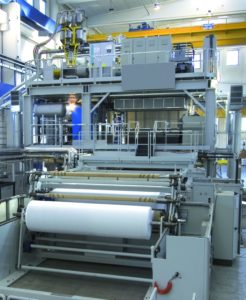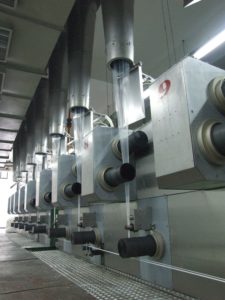Field of application

GEOTEXTILE HIGH TENACITY STAPLE FIBERS
The geotextile nonwoven materials are in a new phase where quality has became very important due to better performance with tighter standards is required. Geotextiles, thanks to their versatile properties, find applications in all the main construction fields such as on constructing roads, bridges and highways, railways, airports, landfill, geocontainer, pipelines and pipe drain, artificial beaches, sea wall construction and sea banking up, drainage for irrigation, drainage and reinforcement for building. Taking into consideration that in some areas (e.g. Far East) the demand of geotextile has a positive growth trend of more than 15% up per year (growth average on the last five years), we are going to see a situation where several new spinning and lines for non-woven fibres to produce geotextile have to be installed within the next years.
The market for non-woven geotextile applications is strongly demanding special fibers to improve the characteristics of the final web allowing the reduction of the product weight, keeping or increasing its mechanical properties. In this way it is possible for producers reducing their costs due to a lower raw material consumption per square meter for the final product.
This trend has become one of the decisive points for the triumphal march of the high-tech non-woven geotextile and it is “a must” for the companies willing to enter into this field keeping their profits growing. The high fiber characteristics are achieved with the one step compact lines designed by us where important solutions for geotextile fibers have been developed in the spinning and in the draw sections. The sort of polymer that is utilized in high performing geotextile is mainly Polypropylene which gives to the staple fiber above high quality. We are the main supplier of complete lines for the production of staple fiber dedicated to geotextile. Indeed, all the main producers of geotextile worldwide are achieving their best results using one-step compact staple fiber lines from us as we are the number one supplier of staple fibre lines designed according to this lay-out.
SPUN BONDING TECHNOLOGIES
Industrial mono and bicomponent spunbonding lines are under operation and their products are already well-established in the european markets.
The available configurations of the lines do vary from single to multi beam, either for spunbond and for meltblown, from single S to SSMMXS. Therefore, the full range of the market demand, beginning from hygienic to geotextile field, is covered at its whole scope. For the installation, the lines do not require any special pre-preparation or fitting regarding the building they are being used inside and no extraordinary axcavation works or pits are necessary to erect them. There is no need for air to be compressed for the draw and suction in the web forming unit. This is one of the important factors which dropped the energy consumption to levels not have been possible before.
The knowledge once acquired from the construction and start-up of several bicomponent lines has been transferred later on to spunbond lines as well where bicomponents managed to gain a predominant position among the non-woven specialties. Polyolefin (PP, PE) and polyester (PET, CoPET) polymers are mainly utilized for spunbond bicomponent and special spinnerets have been realized according to the sheath-core, side by side and segmented pie profile.
Our spunbond lines produce bicomponent with weight from 8g/m2 having filament count lower than 1 den. Bicomponent spunbond with hydroentanglemend units in line downstream, allows the production of spunlace products having a very high softness, tenacity and bulk. Products having above characteristics are combined in line with other webs, films or pulp to give multilayer non-wovens. Bicomponent spunbond with carded web, bico fibers and pulp can be hydro or air interlaced to obtain other new multilayer products. They can be produced with high throughput and with saving on energy costs, building resources, manpower and without high investment needs. Polypropylene and Polyester (virgin chips or bottle flakes) spunbonds are used in line with needle punching looms and products from 150 to 1000 gsm for geotextile, roofing, building and civil applications. At our facilities, both staple fibres and spun bond bicomponent lines are available for research and development of new products; in accordance to customers’ requests, tailored trials and samples can be manufactured.
BICOMPONENT STAPLE FIBRES LINE
Two-step spinning lines are supplied by us for the offered of bicomponent staple fibers, for new kind of fibres and for special and technical applications. Bicomponent fibers such as PET-PP, PET-PE, PP-PE, PP-PA, PET-PA can be made from the lines offered by us. Several cross sections are available and the fiber thread is from 1,2 den per filament. Among these products, an important role is played by the low melting PET-CoPET fibres as well. These quite new sorts of polymers do have a melting temperature below 110°C finding interesting applications in the application field of non-woven fibres. CoPET can be utilized as outer layer of bicomponent sheath-core fibres where the ratio between the two components is from 50-50 to 20-80 and the spinnability of the CoPET presents certain peculiarities which can be solved with the two step process. Today industrial lines are already working in Europe and Asia for the production of low melting bicomponent staple fibres with two steps process.
The same lines are also utilized for the production of hollow conjugate side by side fibers using virgin or recycled polyesters.
We have first developed industrial lines for several special products such as
– PET staple with wet extrusion, starting from undried PET bottle flakes or amorphous granules
– PLA sustainable staple fibers
– staple fibres using multilayer PET-PA bottle flakes
POLYPROPYLENE STAPLE FIBERS to REPLACE ASBESTOS in CEMENT APPLICATIONS
In the light of the latest information confirming the dangerousness of asbestos which has been proved to be an extremely carcinogenic agent polypropylene staple fibres are giving their contribution in order to make easier and more feasible to replace asbestos with a chemical fiber. It is known that short fibers are mixed into concrete to give better performances such as reduction of plastic shrinkage and plastic cracking and to increase the surface properties and durability of hardened cement derivate products. Asbestos was the commonly used fiber for up to now and still is the one giving the best characteristics to improve concrete. Unfortunately, asbestos has been proved to generate serious health problems both to the people who work with it and to the ones living close to articles manufactured with and containing it.
Therefore, in almost all the countries is got prohibited by law to utilize asbestos anymore and there are campaigns to replace the existing products containing asbestos with ones so but it.
Now, we have realized a new configuration of a SUPERSTAPLE line dedicated to produce a polypropylene based staple fiber having characters similar to the asbestos fibers with the aim to replace them fully. Indeed, with new staple fiber line have offered short cut PP fibers at high tenacity, low elongation and with a single fiber thread as fine as 0, 48 count. Thanks to the very fine thread diameters and because of the high tensile properties, such fibers are behaving almost the same as asbestos with it extremely fine fibers are doing alike. With the new fibers, offered articles such as ducts, corrugated roof sheets and roof tiles which are typical for fiber cement applications, can be realized with very good technical results. Other important application fields can be seen in the reinforced concrete for tunnels, galleries, dams, beams, columns, structures and frames where there is a benefit also in the earthquake resistance as well.
BICOMPONENT PET-PE, PET-PP, PP-PE, PET-CoPET, and HCS staple fiber line

